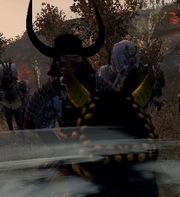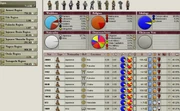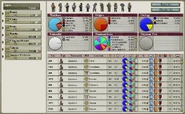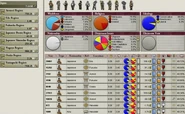
The Tokugawa Shogunate was a shogunate led by the Tokugawa clan from 1603 to 1868, reigning for exactly 265 years. It was founded by Ieyasu Tokugawa after victory at the Battle of Sekigahara, where he crushed his Toyotomi opponents, and oversaw years of peace. In 1868, the shogunate was destroyed as the result of the Boshin War, with the Empire of Japan taking power.
History[]

The Tokugawa clan of Mikawa Province were loyal to the Oda clan from 1562, after Nobunaga Oda took Ieyasu Tokugawa into his clan and let him retake Mikawa Province from the Imagawa clan. In 1582, when Nobunaga was slain, the Tokugawa were some of the first to get involved in the succession crisis, fighting the Toyotomi clan of Hideyoshi Hashiba. Backed by Nobukatsu Oda, they were given a legitimate claim. However, in 1584, they were defeated at the Battle of Komaki-Nagakute by Hideyoshi, who took the Tokugawas in as vassals. Ieyasu remained an ally of the Toyotomi until Hideyoshi's death in 1598, when Ieyasu again tried to claim succession. He crushed the Toyotomi at the Battle of Sekigahara in 1600, and took the shogunate over in 1603.
From 1603 to 1868, peace was common in Japan. There were rare conflicts, such as the Toyotomi peasant rebellion in Osaka Castle in 1615 led by Hideyoshi's son Hideyori Toyotomi, which was brutally crushed. In 1868, the shogunate was overthrown by the Tosa, Choshu, and Satsuma clans, who reinstated Imperial authority over the country. Yoshinobu Tokugawa, the last Shogun, put up a good fight alongside the Aizu, Nagaoka, and Jozai clans, but their allies in France were outmatched by the Imperial allies of Great Britain, who gave them Gatling Guns and Armstrong Guns, which mowed down the Samurai. At last, the Fall of the Samurai was at hand.
Culture[]

The Japanese population in 1840
By 21 January 1840, the population of Tokugawa Japan was 7,110,000 people. 97.7% were Japanese and 2.2% were Ainu. 78.5% were Mahayana, 19.5% Shinto, and 2% Animist. The region with the largest population was Osaka with 2,240,000 people; the second-largest was Fukuoka with 1,070,000, and the third was the capital of Edo, with 1,060,000 people. The least-populated region was Bonin with 41,110 people, with the second-smallest of Shumshu jumping up to 251,630 people. The Bonin Islands were small in population due to their distance from Japan, 620 miles south of Tokyo/Edo.



